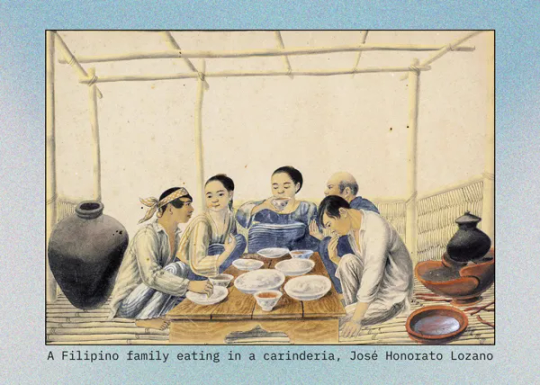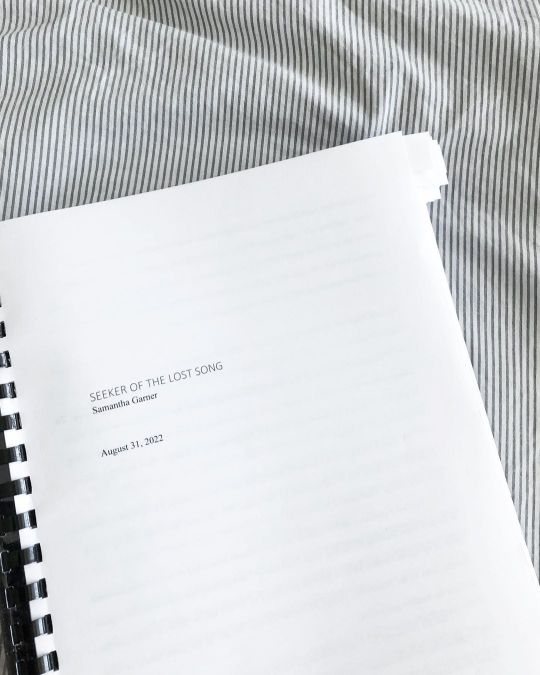I’m Samantha Garner, a Canadian author of character-driven SF/F inspired by Filipino & Finnish history, folklore, and culture 🇫🇮🇵🇭. I write books about outsiders who want to live their lives but end up unravelling the fabric of their whole world instead. My debut novel is The Quiet is Loud. In my work you’ll find: Explorations of identity, belonging, and character; nuanced relationships; atmosphere over action; narratives driven by underdog characters’ internal struggles; genre-blending elements; Filipino and Finnish/Nordic culture; lovingly-written descriptions of food. ___ samanthagarner.ca | Instagram @samanthakgarner | All my links Join my monthly newsletter for behind-the-scenes updates - and a free fantasy story!
Don't wanna be here? Send us removal request.
Text

Exciting news: Seeker of the Lost Song isn’t called that anymore! I've been mulling over new title ideas for a long time. I wanted one that I felt better represents the story and its particular fantasy novel vibes. And, to be honest, I wanted a shorter one too. I don’t mind long titles but since it’s my own book and a title I’ll probably have to say for years, I fancied something a little more manageable. I also wanted one that would work well with the book’s sequel, and I didn’t even know I was writing a sequel when I chose the original title.
Okay, enough waffling. The novel formerly known as Seeker of the Lost Song is now called Twist the Branch.
It’s fun to say. It’s active. It fits the vibe so much better. It pairs so nicely with its sequel title (Corrode the Song). And I think they both sound pretty metal, which is always something I like in a fantasy novel title. I actually feel such a deep aversion to titling projects, so having one I actually like is nothing short of miraculous. 🤘🏼
Let me reacquaint you with the story:
“History begins where magic ends”
Elis Kalevi knows that standing out is dangerous in the Leitir Empire. The Vetsi people survive by reporting their neighbours’ unconventional behaviour to the ruling Leitir. Fear keeps Vetsi from asking why their stories and language are suppressed, and why their collective history only begins five hundred years earlier with the mysterious Division. Questioning the edicts of Empire violates Memorylaw and is punished by something known only as “rehabilitation.”
Elis struggles to stay on the right side of scrutiny. But when her brother loses control of his forbidden nature magic and they’re both marked for rehabilitation, they escape towards an awakening magic in the east—and the unfamiliar memories of ancient spell-song Elis starts receiving. Travelling through the paranoid Empire with the only two people she trusts and two enigmatic strangers, Elis must uncover her people’s buried history before her mind is overtaken by someone else’s memories. Or before their deception catches up to them.
Twist the Branch is a character-driven adult fantasy novel inspired by medieval Sweden’s rule of Finland and pre-colonial Filipino culture, exploring the mutability of history, the power of the collective, and small actions that fracture oppressive systems. Ideal for fans of Robin Hobb characters, Kazuo Ishiguro reflection, and Skyrim atmosphere.
Photo © Samantha Garner, 2025.
#amwriting#fantasy novel#canadian author#finnish history#filipino history#twist the branch#samantha garner
2 notes
·
View notes
Text
Stone Grown is a (free!) fantasy short story set in the greater world of my novel Twist the Branch (formerly known as Seeker of the Lost Song) and its sequel-in-progress. It’s historically-inspired and draws on Finnish and Filipino folklore and customs. Its setting, the Leitir Empire, is basically an extension of my “Finns are not Norse/Scandinavian” history bugbear. It’s inspired by the way Finland was bounced around between Sweden and Russia for centuries, and the way the Philippines was bounced from Spain to the States. What happens when a culture’s language, stories, and traditions are suppressed or twisted to be used against them, for example? The Leitir Empire isn’t a direct analogue of any one country, but I can’t deny how many real-world stories and “what-if”s inspired its creation. Stone Grown continues that exploration, and it’s free as a thank-you gift to subscribers to my newsletter, Deadmedia.
You can read more about the writing process – and the song that inspired it – here.
Some of Stone Grown’s historical & folklore inspirations:
Turku Castle in the medieval period, under Swedish rule. Specifically:
The labyrinth carved into the wall in the Ladies’ Parlour to trap evil spirits
The Scriptorium
Tuonela, the Finnish land of the dead, and its associated characters
Pre-colonial Filipino death rituals
When you join Deadmedia, you’ll get updates on what I’m working on, book news, thoughts on creativity, and other exclusive content. I send a newsletter on the 15th of each month, with infrequent emails in between if there’s time-sensitive news. I look forward to seeing you there!
2 notes
·
View notes
Text
Historical inspiration for my fantasy novel: foreign rule in Finland & the Philippines

Why do I write historically-inspired SF/F set in societies that disregard personal autonomy? I admit, when I first noticed it I got a little concerned. Shouldn’t I be writing about dragons or something lighthearted and fun? Then I took a step back and looked at the broad strokes history of my parents’ countries of origin. 🇫🇮 Finland: Under Swedish rule for hundreds of years, then ceded to Russia until full & formal independence in the 20th century. 🇵🇭 The Philippines: Under Spanish rule for hundreds of years, then ceded to the USA until full & formal independence in the 20th century. This is what I grew up hearing about. I don’t pretend to have a perfect understanding of the events and of course the above are over-simplifications of complicated histories. But these stories are in my blood. No wonder I can’t stop writing about this shit! I have this innate need to tell stories inspired by Finnish and Filipino history and mythology, even if it’s not direct. My second novel Twist the Branch (formerly known as Seeker of the Lost Song) and its sequel are inspired by the history of Finland and the Philippines, but that theme of autonomy shows up in my unrelated novellas-in-progress too. My books are character-driven and not direct commentaries on imperialism and colonialism. You won’t find clashes of large armies or overt revolutionary heroism. Yet being inspired by this history means my characters’ struggles stem from just wanting to define their own lives. Should be simple, but history proves again and again that it’s not. By the way, I’m sure this is also fueled by the draw I’ve had to outsiders my whole life, and my own feelings of being an outsider. But I’ll end this here – I already feel like an old hippie just ranting about “the Establishment, maaaaan!” My brand, I suppose!
(PS I also love dragons.)
#seeker of the lost song#fantasy novel#filipino history#finnish history#historical fantasy#amwriting#samantha garner
2 notes
·
View notes
Text
How I start my worldbuilding process as an SF/F author

Ninety-nine percent of the time, my novels start with a character, theme, or “what if” situation – The Quiet is Loud started with a woman with prophetic dreams predicting her mother’s death. Twist the Branch (formerly known as Seeker of the Lost Song) started with the idea of people who don’t remember their own history. Its sequel started when I finished writing Seeker and a totally different character slid into the proverbial room, letting me know I wasn’t finished with that world.
1) Setting
After the initial story idea, I typically figure out the setting. For me, where the idea will live is part of the story itself. I spend time on details that I feel are critical in creating a good story and believable characters. For example: What’s the climate? What are the flora and fauna? Where do people live? What do they eat? What do they wear? The answers to these questions can lead to some interesting worldbuilding-y answers
In my novel Twist the Branch, the Vetsi people grow rye and apples like in our-world Finland, but also rice and ube like in our-world Philippines. This is because its magical forest makes it possible to grow crops that normally aren’t seen together.
2) History, mythology & language
Sometimes this is where I start my worldbuilding, or sometimes it comes earlier in the process as I’m creating the characters. I’ll just freewrite the society’s history, losing myself in my imagination. Sometimes the history and mythology are based on real-world history and mythology, and in that case I’ll note what I’m changing and why. If I have to change real history that affected real people, I need to have a really good reason.
When it comes to the language and the names of people and places, I like to ground them in something from our world as well. This way I’m more confident that names will sound cohesive when necessary. However, language being incongruous is also realistic, as any English-language speaker can tell you. In my novella series, the settlers of its tidally-locked planet have Earth-names like Mi-kyung and Cécile, but some have more comparatively fantastical names like Jhaeros and Ektelian. To my mind, when you spend a century and a half building your society on a far-flung planet that’s been all but forgotten by Earth, you likely won’t be beholden to Earth’s naming conventions for very long.
3) Society & daily life
Some questions I ask myself about my characters’ lives and society are: What are their jobs? Who’s in charge? What’s the class system? What’s their economy like? Not only do the answers to these questions help to develop character, but they also offer chances for delicious little societial micro-conflicts that I love. As a writer, that is.
Of course, the worldbuilding process doesn’t end there, but these are my foundational elements. I spend a lot of time on worldbuilding and I don’t have a set pathway that I go down each time, but these are the top three ways I start my worldbuilding process as a sci-fi/fantasy author.
This post first appeared on my blog as a modified newsletter issue - find out more about that here!
#amwriting#fantasy novel#scifi novel#science fantasy#writing tips#worldbuilding#writing inspiration#canadian author#samantha garner
4 notes
·
View notes
Text
Historical inspiration for my fantasy novel: Early Finns, Sámi, and “unnatural” magic

Twist the Branch (formerly known as Seeker of the Lost Song), my latest completed novel, is historically-inspired fantasy merging medieval Finnish & pre-colonial Filipino elements. Some key historical inspirations for the novel are the Swedish rule of Finland, and the Scandinavian belief that early Finns and Sámi practiced unnatural magic.
In the years I spent writing this novel, I changed the setting twice. But I soon found myself stuck. During a conversation with a friend I started telling her about a vague “historical fiction in Finland” idea I’d had for a long time. The more we talked about ideas and inspirations, the more home it felt. The more urgently I wanted to be there instead. And so we said – why not just do it?
Could I really fold the historical Finland idea into my novel? It seemed like a perfect fit. Early Scandinavians thought Finns and Sámi were forest weirdos who practiced unnatural magic. Firsthand accounts by/about Finns were scarce to nonexistent, both before and during the Swedish rule of Finland. And I’d always felt that the Finnish story was missing in the Viking/Norse saturation of books, video games, movies, and TV (woe betide the poor soul who inadvertently gets me talking about how Finns are Nordic but technically not Norse/Scandinavian). BUT. ANOTHER new setting?! I’d spent so long working on this book. I just wanted to write it.
I wrote about this a bit more on my blog, and - spoiler alert - changing the setting again was a good idea!
___
Photo © Samantha Garner, 2024.
4 notes
·
View notes
Text
The Quiet is Loud & old Filipino restaurants

There’s an old-school style of Filipino restaurant called “turo-turo.” The name is an example of classic Filipino word reduplicating, and stems from the word for pointing at something. They’re often located in strip malls, and the typical feature is their cafeteria-style presentation, all food laid out in warming trays that you point at and someone dishes up for you.
As a child I didn’t know the turo-turo style of restaurant had a name—I just learned it recently. To me, they were always just “Filipino restaurants.” They always made me feel a mix of contentment and confusion. I was excited to have my favourite food, but also intimidated by the context I lacked for much of it. I would stand in front of the glass separating me from the food, looking at the names of each dish written there, wondering what some of them were.
In a recent blog post, I wrote a bit about the history of this style of Filipino restaurant and how I used them to create my own version of Filipinoness in my literary sci-fi novel The Quiet is Loud. Check it out here!
PS You can probably tell that the picture at the top of this post wasn’t taken in a restaurant; it’s from a wonderful Filipino picnic I attended a couple of years ago, a birthday party for a friend’s child (side note: eating Filipino food in a park is another core memory of mine that I love).
0 notes
Text

There are many themes and inspirations in The Quiet is Loud that I feel are quite overt – just a few off the top of my head: identity, belonging, self-reflection, mythology, tarot cards, Filipino food, and unexpected friendships. But I thought it might be fun to share four inspirations that are a little more unusual.
Check out my blog post for more! Spoiler alert: X-Men and the concept of shitty superpowers, a specific relationship in Jessica Jones, a specific character from Dragon Age: Inquisition, and a certain stock photo model who is EVERYWHERE.
#fantasy novel#sci fi and fantasy#scifi novel#x men comics#jessica jones#dragon age inquisition#dragon age#the quiet is loud#writing inspiration
0 notes
Text
Filipino & Finnish mythology & folklore in my recent work
Today I'd like to share the Filipino & Finnish mythology & folklore I’ve incorporated in my work so far. This includes The Quiet is Loud, Twist the Branch (formerly known as Seeker of the Lost Song), TTB’s sequel, and my new science-fantasy novella Tempest Ascending.
Folklore/mythology from the Philippines:
✦ Nuno sa punso, a nature spirit who takes the form of an old man living in a mound of earth ✦ Tikbalang, a half-horse, half-human trickster who lives in the forests and mountains ✦ Siyokoy, a humanoid sea creature with a scaled body, large red eyes, and sharp teeth ✦ Engkanto, an umbrella term for various enchanted spirits ✦ A certain deity that I can’t reveal because it’s a spoiler but SO COOL ✦ Actually, make it two, why not?
Folklore/mythology from Finland:
✦ Tuonela, the land of the dead, popularly appearing in the Kalevala ✦ Ukko, the god of thunder, the sky, and weather ✦ Haltija/Haltia, a guardian spirit that protects places or people ✦ Spell-song, which is featured in the Kalevala and also in real-life poem-singing competitions called kilpalaulanta
Honestly, nothing feels more life-affirming than combining the mythology and folklore of both of my wildly different cultures into a cohesive whole that works together. I don’t think it’s too cheesy to say that it feels healing.

Väinämöinen sings Joukahainen into a mire, Joseph Alanen. Tempera painting with a motif from Kalevala 1912-1913.
#amwriting#fantasy novel#science fantasy#sci fi and fantasy#seeker of the lost song#the quiet is loud#filipino history#finnish history#filipino mythology#finnish mythology#kalevala
15 notes
·
View notes
Text
Say hello to my new science-fantasy novella!

Say hello to the first draft of my new science-fantasy novella, Tempest Ascending! I finished it almost exactly one year after making my initial notes, which I didn't realize until yesterday. That freaked me out a little - it's the same thing that happened with The Quiet is Loud.
The novella features:
A tidally-locked planet where the sun never sets
An older woman protagonist, the hunter Alaya Anak ni Soleng
Characters from Filipino & Finnish mythology & folklore
A pursuing crow who seems unusually fixated on Alaya
Characters who don't trust each other
Female anger & cockiness that isn’t “fixed”
Mysterious and erratic weather patterns
Weird metal that seems kind of alive
Themes of belonging, acceptance, and doing whatever you want
I've made a few edits of my own and sent it off to beta readers, and I'm excited to make some edits and develop things even more.
___
Photo © Samantha Garner, 2024.
#amwriting#fantasy novel#scifi novel#science fantasy#filipino history#finnish history#samantha garner#canadian author
1 note
·
View note
Text
Historical inspiration for my fantasy novel: Pre-colonial Philippines
Twist the Branch (formerly known as Seeker of the Lost Song) is a historically-inspired fantasy novel merging medieval Finnish & pre-colonial Filipino elements, and I wanted to share two elements of Filipino history I included.
☼ 1) Dulang, a low table ☼

One of my favourite tidbits from my research is that pre-colonial Filipinos ate at a low table, sitting on the floor. Part of me worries that readers will think “Hey you stole that from Japan!” but I’m excited for the chance to show my people at their own low table, eating rice with their hands.
☼ 2) The balangay boat ☼

Another pre-colonial Filipino element I included in the book was a balangay, an ancient Filipino boat that’s recently come back into the public consciousness, with ancient boats being excavated and working replicas made. A quote from this article in STARweek, from one of the people who worked to rebuild the balangay, really resonated with me:
“It is very sad because we are a maritime people. We should be gifted and natural in the waters but colonialization robbed us of that consciousness. I am doing this to help rekindle that spirit”
The balangay that appears in my novel has a double outrigger (something that always feels so Filipino to me), but essentially it’s a larger version of the sketch pictured. And I have to admit, the scenes on the balangay did stir something in me. Something ancient and ancestral, perhaps?
TTB’s as-yet-unnamed sequel also features elements of pre-colonial Filipino history, but more on that at another time. Suffice it to say I’m enjoying this opportunity to learn more about the history of my people and use it in a fantasy setting!
#amwriting#fantasy novel#seeker of the lost song#filipino history#canadian author#asian authors#southeast asia#precolonial philippines#asian fantasy#filipino fantasy
24 notes
·
View notes
Text

The world of my new fantasy novel Twist the Branch (formerly known as Seeker of the Lost Song) is inspired by pre-colonial Filipino culture, as well as the medieval Swedish rule of Finland. Its sequel is additionally inspired by the later Russian control of Finland. Finnish history is a major inspiration for both novels, even though they’re not historical fantasy.
Lord of the Rings was the first fantasy novel I read, way back at the age of 13. I read the Silmarillion shortly after that, and fell deeply in love with the world, the mythology, and the language. I didn’t intentionally set out to model TTB and Sequel after Tolkien’s work. I mean, they aren’t epic fantasy novels, and Tolkien’s specific flavour of worldbuilding has been done over and over ad nauseam.
However, there are five subtle ways that Tolkien’s influence has made its way into my work that I can’t deny.
(NB: Spoilers ahead for some of Tolkien’s work – proceed with caution!)
Read the full blog post here!
🧝🏼
#amwriting#fantasy novel#seeker of the lost song#finnish history#filipino history#lord of the rings#lotr#silmarillion#tolkien#jrr tolkien#asian fantasy#filipino fantasy
4 notes
·
View notes
Text

Since 2008, I’ve taken myself on three DIY writing retreats. I’m sharing the things I’ve learned about DIY writing retreats, and what I’d do differently next time. Or, will there be a next time?
You can read a detailed breakdown of each retreat at my blog, but here's the TL;DR:
Writing retreat #1: 2008, the small boutique hotel in an urban neighbourhood
Score: 5/10 Pro: Being able to walk to get coffee in an interesting neighbourhood was good for a brain break. Cons: Thanks to making absolutely no plans, I spun my wheels for most of the weekend instead of working. Additionally, choosing a boutique hotel with virtually no amenities meant that I was on my own for many things – no room service or in-room coffee, for example. If I had been in a writing phase, having to leave the hotel for these things wouldn’t have been ideal.
Writing retreat #2: 2018, the Airbnb farmhouse in the country(ish)
Score: 8/10 Pro: A quieter space with food and caffeine readily available helped me to focus and work. Cons: Good ol’ Sammy No-Plan strikes again - I didn't know exactly what I wanted to focus on. Also, the physical isolation felt a bit depressing at times. I was able to drive into town and go to a coffeeshop to write for a while, but I found myself actually missing the more “peopley” hotel environment now and then.
Writing retreat #3: 2023, the hotel in the suburbs
Score: 5/10 Pros: She made a writing plan! Amazing! Additionally, the room was clean and comfortable, and big enough that I didn’t feel as boxed in as I did in 2008. Having room service and in-room coffee plus easy access to a grocery store helped a lot too. Cons: LOUD HOCKEY TOURNAMENT PEOPLE. This would have been a 9/10 weekend if not for the hockey people.
___
Photo © Samantha Garner, 2023.
0 notes
Text

If you could thank non-humans in your book's Acknowledgements page, what would you include? For Twist the Branch (formerly known as Seeker of the Lost Song): ᕯ The "askhistorians" subreddit ᕯ Wiktionary ᕯ nordicnames.de ᕯ Inkarnate's map creator ᕯ Genesis albums Foxtrot & The Lamb Lies Down on Broadway
My book wouldn’t be what it is without them! ___
Photo © Samantha Garner, 2023.
#seeker of the lost song#samantha garner#canadian author#fantasy novel#filipino history#finnish history#amwriting
2 notes
·
View notes
Text

⋇ IN PRAISE OF OLDER PROTAGONISTS ⋇ What are your favourite books with "older" protagonists? In The Quiet is Loud, Freya is 28. In Seeker of the Lost Song, Elis is 32. In Seeker's sequel, Aurin is 35. When I wrote each of them I was a few years older than they were. It wasn't a conscious decision at first - I just haven't been in my early twenties for a long time. I find it more natural to explore the ways "older" people grow, fuck up, discover themselves. I do read and enjoy books with early-/mid-twenties protagonists. But honestly, to think that there's no space for your world to be rocked once you hit 30 is laughable. I’m 43. I do NOT have my shit together. I probably never will have my shit together, because I am a living human person always experiencing new things. The last eight or so years have seen the most change of my entire life. The difference is that it's internal, more personal. I may not impulsively cut my own hair anymore or post 2am self-portraits online with a "THIS IS MY ART, DEAL WITH IT" energy anymore, but the desires at the heart of those things are still churning in me. I'm always going to be a little messy. I'm just messy with more life experience. Also, from a storytelling standpoint I just think it's cool to have an older protagonist go on a quest. We know what we like. We often have less energy. We often have more responsibilities. We often face harsher societal expectations. These are ALL things that can add the most delicious tension and perspective to a story. In one of my favourite books, Fool's Errand by Robin Hobb, 35-year-old Fitz reluctantly leaves his safe and comfortable life to go on a quest for the first time since he was 20. Does he complete his quest capably and maturely? The fuck he does! And to me that's more interesting. He fights against his life experience, the lies he's told himself for 15 years, and he changes. From the opening scene of the book: "I no longer had the excuse of callow youth, and I could not yet claim the eccentricities of age." ___
Photo © Samantha Garner, 2022.
0 notes
Text


"The Lucid Fever Dream" chapter is what I call one of my favourite The Quiet is Loud chapters. Despite it being a very tumultuous night in Freya's life, it was so much fun to let loose with fantastical imagery and Filipino mythology/folklore characters (my dude nuno sa punso says hey later on in this chapter).
It was one of the chapters that flowed out of me quite freely, seemingly without me having to do much. Was I dreaming when I wrote it? Was I awake? Somewhere in between? Who can say? ___
Photos © Samantha Garner, 2023.
#the quiet is loud#samantha garner#canadian author#scififantasy#amwriting#filipino history#filipino mythology#norse mythology
0 notes
Text

What's your favourite thing about novel worldbuilding? For me as a fantasy author, it's language. Specifically, finding the vernacular that makes sense in the world I'm creating. I'm one of those people sits up and says, "wait a minute" when someone in a secondary world fantasy speaks Latin, or who stops reading to look up a phrase someone said because I suspect it has historical relevance in our world and our world only.* For example, there is no religion in the world of my fantasy WIP Seeker of the Lost Song. This means obvious things like nobody says "oh my god" or "damn." But it also means that the Leitir Empire is driven not by some sense of divine right, but by altogether human and grounded beliefs. And so I have to think of the ways that people who prop up an empire like this would speak. How do you subjugate a people without the interpreted will of a deity to back you up? What sorts of words and language would you use? Seeker is historically-inspired fantasy and not historical fantasy, so I don't have to follow a prescriptive language timeline that maps to a specific time period. But it's still endlessly fascinating and fun to find myself naturally typing a turn of phrase and then think, "Wait, does it make sense for them to say that?" (* My weird origin story: In high school I took Xena: Warrior Princess more seriously than I should have and rage-quit the moment someone said, "My bad!") ___
Photo © Samantha Garner, 2023.
#seeker of the lost song#samantha garner#canadian author#fantasy novel#filipino history#finnish history#amwriting
1 note
·
View note
Photo

Some things I researched for Seeker of the Lost Song: ☾ Medieval pottery techniques ☾ Medieval Finnish saunas ☾ Native trees of the Philippines ☾ Pre-colonial Filipino ships & boats ☾ A fuckton of etymology from Old Norse, Old Swedish, and Finnish ☾ How long it takes to walk across Åland and Finland (surprisingly not that long!) ☾ Temple economies ☾ Natural dyes and inks ☾ Forest glass ☾ Sod roofs ☾ Birch paper And the little historical tidbit that basically kickstarted the fantasy aspect of the novel: That medieval Scandinavians thought medieval Finns* were wizards. ___ *(In this context “Finns” likely meant “Sámi,” but still - how could I not be intrigued?!)
Photo © Samantha Garner, 2022.
#seeker of the lost song#samantha garner#canadian author#fantasy novel#filipino history#finnish history
6 notes
·
View notes